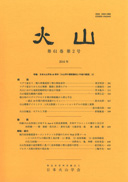Volume 60, Issue 3
Displaying 1-13 of 13 articles from this issue
- |<
- <
- 1
- >
- >|
-
Article type: Photogravure
2015 Volume 60 Issue 3 Pages App1-
Published: September 30, 2015
Released on J-STAGE: March 20, 2017
Download PDF (5193K) -
Article type: Article
2015 Volume 60 Issue 3 Pages 299-308
Published: September 30, 2015
Released on J-STAGE: March 20, 2017
Download PDF (5427K) -
Article type: Letter
2015 Volume 60 Issue 3 Pages 309-315
Published: September 30, 2015
Released on J-STAGE: March 20, 2017
Download PDF (1763K) -
Article type: Letter
2015 Volume 60 Issue 3 Pages 317-324
Published: September 30, 2015
Released on J-STAGE: March 20, 2017
Download PDF (13896K) -
Article type: Letter
2015 Volume 60 Issue 3 Pages 325-332
Published: September 30, 2015
Released on J-STAGE: March 20, 2017
Download PDF (3507K) -
Article type: Letter
2015 Volume 60 Issue 3 Pages 333-340
Published: September 30, 2015
Released on J-STAGE: March 20, 2017
Download PDF (5924K) -
Article type: Letter
2015 Volume 60 Issue 3 Pages 341-348
Published: September 30, 2015
Released on J-STAGE: March 20, 2017
Download PDF (5243K) -
Article type: Letter
2015 Volume 60 Issue 3 Pages 349-356
Published: September 30, 2015
Released on J-STAGE: March 20, 2017
Download PDF (1514K) -
Article type: Article
2015 Volume 60 Issue 3 Pages 357-363
Published: September 30, 2015
Released on J-STAGE: March 20, 2017
Download PDF (1127K) -
Article type: Article
2015 Volume 60 Issue 3 Pages 365-380
Published: September 30, 2015
Released on J-STAGE: March 20, 2017
Download PDF (3608K) -
Article type: Article
2015 Volume 60 Issue 3 Pages 381-397
Published: September 30, 2015
Released on J-STAGE: March 20, 2017
Download PDF (2125K) -
Article type: Letter
2015 Volume 60 Issue 3 Pages 399-410
Published: September 30, 2015
Released on J-STAGE: March 20, 2017
Download PDF (6105K) -
Article type: Commentary on Photogravure
2015 Volume 60 Issue 3 Pages 411-415
Published: September 30, 2015
Released on J-STAGE: March 20, 2017
Download PDF (477K)
- |<
- <
- 1
- >
- >|
